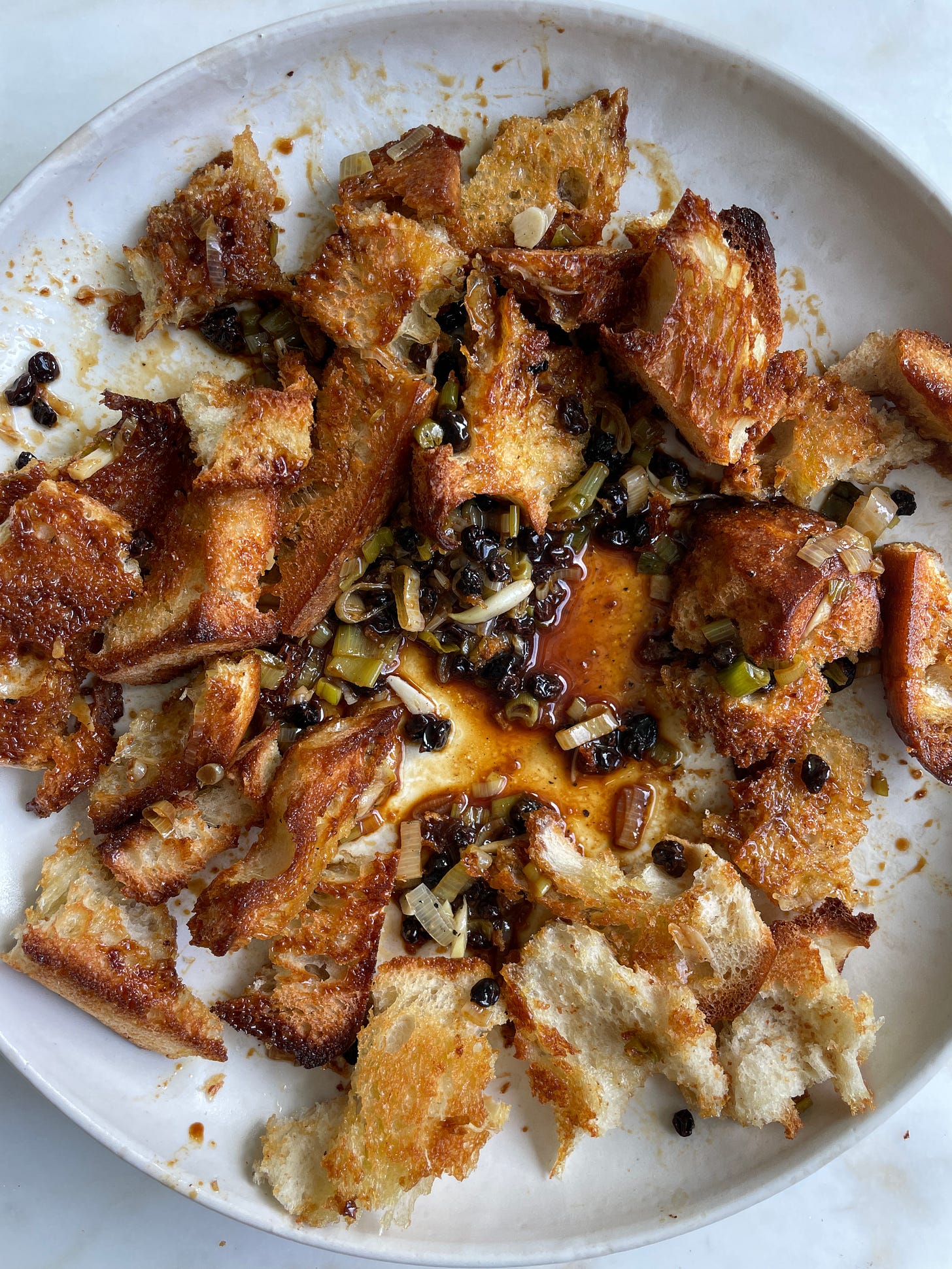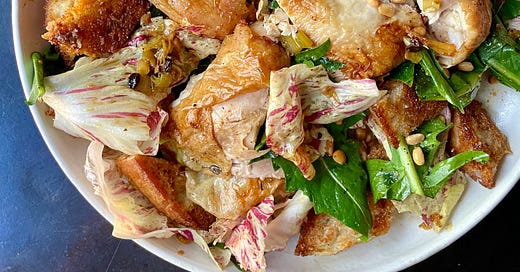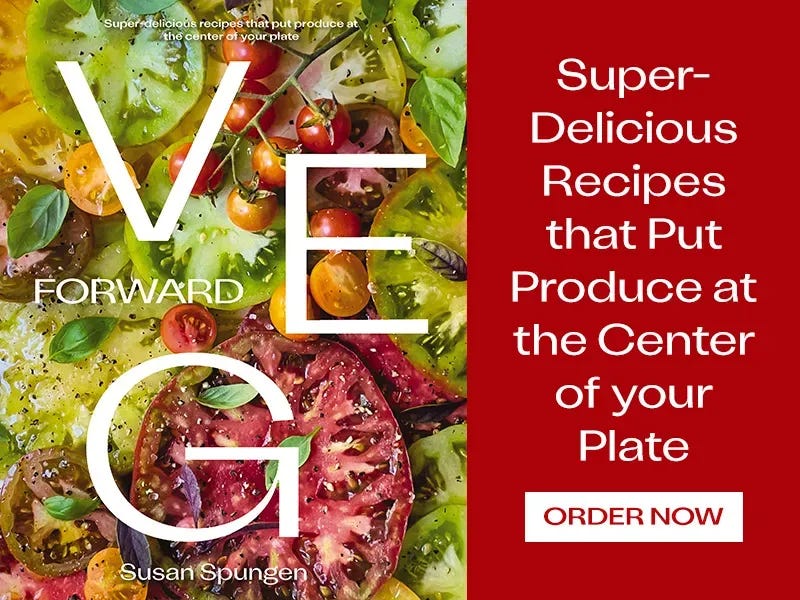First of all, happy new year! I enjoyed a little quiet time with family and friends over the last few weeks, and hope you did too! Parties were back in full swing this year, and I enjoyed seeing so many friends. I narrowly dodged a couple of Covid bullets, and hope you came through the holiday season healthy too! With our trip to Paris right after Thanksgiving, December was a whirlwind. It’s always a bit of a relief when it’s all over, isn't it? Phew.
It’s also a bit of a relief to get back to a somewhat normal diet. Cookies are no longer on the menu, at least for the moment (but don’t worry — special desserts will always be part of the Susanality equation!). I cooked FIVE dishes from Veg Forward for a live TV segment I did yesterday (I’m writing this on Wednesday), so Steve and I have been enjoying those for every meal since. I shopped and cooked all throughout New Year’s weekend to be ready for the segment on January 2nd! Click here to watch it and see which dishes I made. I was especially glad to see my old friend Okonomiyaki again, and I’ll be making it again soon. It’s the perfect winter recipe, and the leftovers are good for breakfast, lunch, or dinner.
Speaking of perfect January recipes, my rendition of the famous Zuni Café Roast Chicken is what’s on the menu today. If you’ve never been to Zuni Café in San Francisco, please put it on your list and make sure you go if you’re ever in the area. I used to travel to SF often in the ‘90s when I worked at Martha, because we frequently shot in California in the winter, which I didn’t mind at all. My very first stop after landing was often a solo lunch in the sunny corner of the dining room that juts out onto Market Street.
One of the great things about Zuni is that it hasn’t changed in years. It’s one of the most consistent restaurants I’ve ever eaten at. The former owner and founder, chef Judy Rogers, sadly passed away much too young in 2013, and still, the restaurant maintains its comforting high quality. It’s been a few years since I’ve been there, but I know that when I go back, I’ll be greeted by the smell of wood smoke from the oven, and treated to moist Acme sourdough, the platonic ideal of a Caesar salad, a great burger (only at lunch), and the amazing “Chicken for Two.” And so much more. It’s truly a perfect restaurant.
Any recipe for Zuni Chicken is an homage and an approximation, because without that wood-burning oven, it will never be quite the same. One of the amazing parts of this dish is the bread salad that comes with the chicken and mops up all the juices. However, using the technique of salting the chicken well ahead of time, aka dry-brining, and cooking at a high temperature results in an extremely juicy and flavorful bird that’s just perfect for two (but you can easily double the whole thing for a bigger group).
I was reminded of what a great dish this is when my friend Scot made it for a small dinner party just before the pandemic. He was one of the art directors from those Martha days, and we remain good friends. I loved his rendition, and I recently pumped him for information so I could share this recipe with you. I made a few changes (of course!), and I think you will really like the result. It is perfect for a cozy winter dinner for a small group, but isn't too fancy for a weeknight either!

Here are some tips and notes:
This recipe works best with small chickens, so look for the smallest one you can find. Aim for it to be 3 ½ pounds or less.
Season the chicken at least one day ahead — two is even better.
That said, I confess, when I was developing this recipe I did not have 24 extra hours for one of the passes, and it was still wonderful seasoned soon before roasting.
Use “peasant bread” and not sourdough. You actually want a softer, less chewy bread than sourdough.
You can use whatever greens you want, but bitter is best. Leafy arugula (not the baby kind) works, but I used dandelion greens and a mild type of radicchio, which looked and tasted great.
For more tips, watch this video!
Zuni Café Roast Chicken
Serves 2
1 3-pound (or as close as possible to it) whole chicken
2 ½ to 3 teaspoons kosher salt (use 3/4 teaspoon salt per pound of chicken)
1/2 teaspoon freshly ground pepper
Handful of herb sprigs (I used thyme and sage)
4 thick (3/4-inch) slices peasant bread (not sourdough), crusts removed
2 tablespoons extra-virgin olive oil, plus more for drizzling
3 cloves garlic, thinly sliced
4 scallions, thinly sliced
2 tablespoons champagne vinegar (or other mild vinegar)
2 tablespoons dried currants
4 cups torn bitter greens (I used dandelion and radicchio)
2 tablespoons toasted pine nuts
Flaky salt and freshly ground pepper
Pat the chicken dry and loosen the skin on the breasts. Combine the salt and pepper in a small bowl and mix thoroughly. Season the chicken all over, including in the cavity and under the breast skin. Tuck the herbs under the skin and in the cavity. Refrigerate, loosely covered, for 1 to 2 days (see the tips section if you are short on time).
When ready to cook the chicken, heat oven to 475℉. Place the chicken on one side of a sheet pan. Put the bread slices on the other side. Drizzle both sides of the bread with oil, then place sheet pan in the center of the oven.
Turn the bread slices over after 10 to 12 minutes, and cook 3 to 4 minutes longer, until the bread is deep golden brown all over (it should retain some softness in the center). Remove the bread and set aside. Return the chicken to the oven.
After 25 to 30 minutes of total cooking, remove the sheet pan from the oven and reduce oven temperature to 450℉. Carefully turn the chicken. To do so, first gently loosen it from the pan with a thin spatula. Then, using the spatula and a pair of tongs, turn the chicken over. Return to the oven to cook for 15 minutes with the breast side down, and then repeat the turning process. Cook 10 minutes longer with the breast side up. If your chicken is larger than 3 ½ pounds, it may take longer to cook through. Cook until the legs feel loose. Remove from the oven and transfer the chicken to a plate or carving board.
Pour off and discard excess fat from the sheet pan. Place the pan over a burner on the stove and add 1/4 cup water. Bring to a boil and use a spatula to loosen all the brown bits on the pan. Pour the liquid into a small bowl.
While the chicken roasts, make the dressing for the bread salad. Pour the 2 tablespoons extra-virgin olive oil into a small skillet and heat over medium heat. Add the garlic and scallions, and cook, stirring, until softened and starting to turn golden, about 3 minutes. Cool slightly so it doesn’t spatter, and add the vinegar. Add the currants and season with salt and pepper. Pour into a small bowl and set aside.
Tear the bread into pieces and place in a wide bowl. Pour the dressing and the reserved pan juices over top and mix thoroughly using your hands. Add the greens and toss with the bread. Arrange the salad on a serving platter.
Carve the chicken into small pieces and arrange on top of the salad. Pour any juice that collected on the carving plate over top. Season with salt and pepper and a drizzle of olive oil, if desired. Sprinkle all over with roasted pine nuts.
Editor: Molly Ramsey








I made this last night and it was SOOOO GOOD and simple to make. I seasoned the chicken 2 days ahead. The chicken had delicious crispy skin and the breast meat was moist. Everyone loved it.
I love this recipe and your version of it. I have made Judy Rogers' a number of times which is excellent but yours is simpler and amps up the currants ands pine nuts. Hello!! These are essential. One question: though this is not a complicated recipe there are a large number of steps. I'd love to have a recipe that works for company. How/what can I prepare in advance so I am not tied down in the kitchen?